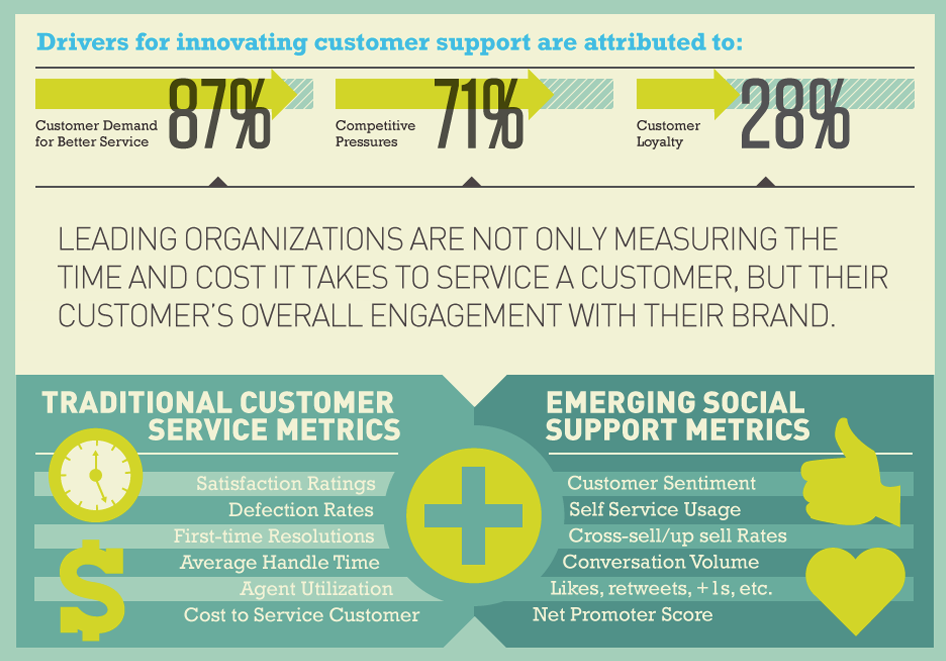By adaptive - May 21st, 2013
It’s noisy out here! How can customer service teams cut through the clatter so they can hear the right conversations to do their jobs?
The modern consumer has a unique kind of power. If they have the right following and say the wrong words, they can actively damage a brand’s reputation and, according to The Drum businesses are losing £12bn a year through poor customer services. According to an infographic researched and developed by Blue Wolf 85% of business can be lost due to poor customer service and 73% of customers have spent more with a company because of a history of good customer service.
If you consider 59% of people will move brands to get better service, how swiftly customer loyalty shifts and how quickly a brand can suffer if they gain a reputation for shoddy customer service, it seems hard to believe that 58% of tweets complaining about a poor experience have not received a response from the brand in question.
“Brands are now made of glass,” says Catriona Oldershaw, UK managing director of Synthesio “Consumers own the reputation of the brand and brands need to tap into this new C2C world, pluck the right insights out of all the noise on social channels, engage in the conversation where appropriate, and drive positive change based on the voice of their customers.”
If, as the Blue Wolf infographic predicts, 90% of enterprises will be using social media to respond to customer and partner service enquiries, how will they do so effectively? How does a customer service team hear the right voices when they are whispering in a crowd?
Social customer service done well can differentiate a good company from a great one, and brands stepping aboard the social train today will be delivering superior service tomorrow. And they can achieve this through the use of specific customer service tools that have been designed to match the needs of this growing demand.
The tools that matter
“Businesses should decide what they want to do with their social presence and then find a system that automates and manages that well,” says Jon Norris, web editor at Crunch Accounting, “Every business is different, and every solution caters to different networks and use cases.”
This is where customer service tools come into their own and can be tailored to listen to what your consumers are saying, and get you the right information on time. In a world where the voice of the unhappy customer is saying, “help me now or lose me forever”, these tools can make all the difference to the way a brand is perceived on social media.
“Customer service tools aggregate information about your brand and the customer experience, they accelerate the speed of hearing where your brand is being talked about, the accuracy of your future communication,” says James Berkeley, managing director at Ellice Consulting.

“A good social customer service tool can provide a central, localised hub of all customer engagement and brand activity across multiple channels,” says Dominic Sparkes, CEO and founder of Tempero. “It can prove useful for identifying issues – tools help listen, monitor, track and identify issues as not all customers contact the brand directly.”
“I have routinely observed in my work for brands like Marriott, Hilton, Shangri La and Peninsula, that social customer service tools can alter customer perceptions about the brand promise,” says Berkeley.
Customer service tools can be used to redefine the way brands interact with their customers online, and to collate information that is essential to the brand’s wellbeing. They can also use other metrics to evaluate key issues, gather data for the future and assess different aspects of the target market. If they are managed and implemented properly, they have the potential to save the business money. They can limit loss of revenue due to poor brand awareness and reputation and as multiple customers are served in one arena rather than one at a time in a call centre, they have broader reach at less cost.
“The fundamentals of customer service haven’t changed,” says Norris, “These tools allow you to deliver good customer service consistently, no matter where the customer chooses to make contact.”
The correct tools can tie together a customer’s social presence, split workloads, make sure repetition doesn’t occur and manage high volumes of social queries per day.
The path to success
Selecting customer social tools that match the multi-platform demands of most brands can be challenging, but there are several solutions out there that are more than up to the job.
“The social management tool space is split between tools that specialise in the management of a brand’s owned social spaces such as Facebook or Twitter, and those that enable brands to listen to, and manage, conversations across both owned and earned (third party) channels,” adds Oldershaw, “The latter are often better suited to online customer service scenarios, as they enable brands to ‘fish where the fish are’ and not just set up shop in some outpost of the web hoping people will to come to them.”
“The social management tool space is split between tools that specialise in the management of a brand’s owned social spaces such as Facebook or Twitter, and those that enable brands to listen to, and manage, conversations across both owned and earned (third party) channels. The latter are often better suited to online customer service scenarios, as they enable brands to ‘fish where the fish are’ and not just set up shop in some outpost of the web hoping people will to come to them," adds Oldershaw.
“Sprout Social is a really nice all-in-one solution, as is SocialEngage from Exact Target,” says Norris, “There are many platform-specific options too, like ZenDesk which is a popular customer support system that offers a Twitter add-on so you can turn tweets into support tickets. This is a booming market so your options are endless really."
“We are really excited about the potential of platforms that incorporate machine learning, such as SoDash” adds Sparkes, “By putting artificial intelligence at the heart of the platform, software can sort incoming messages into queues split by topic or intended audience, ensuring that customer requests get to the right team, keeping admin low and technicians focused on support.”
When selecting the tools for your business Berkeley recommends that you ask four definitive questions:
- What is the end result you expect from this tool?
- With whom will you be communicating?
- What are your scale requirements?
- What trends do you hope to exploit?
It is worth examining tools such as Buffer and Social Flow that have features built in specifically for analysing the real-time conversations about your brand. The latter also boasts an impressive retinue that includes the likes of National Geographic and The Economist. CrowdBooster is worth looking into if you want a more straightforward solution, and ArgyleSocial is a good bet for B2B measurements and metrics.
In our next feature we will be examining how a customer services team should have its performance measured, what metrics should be used, and how the development of the team can be mapped to ensure the deliverables for the business are being met.
Next Reads
October 2013, New York
How you can leverage social media for a more effective customer service function and better customer insight
Brochure Programme
